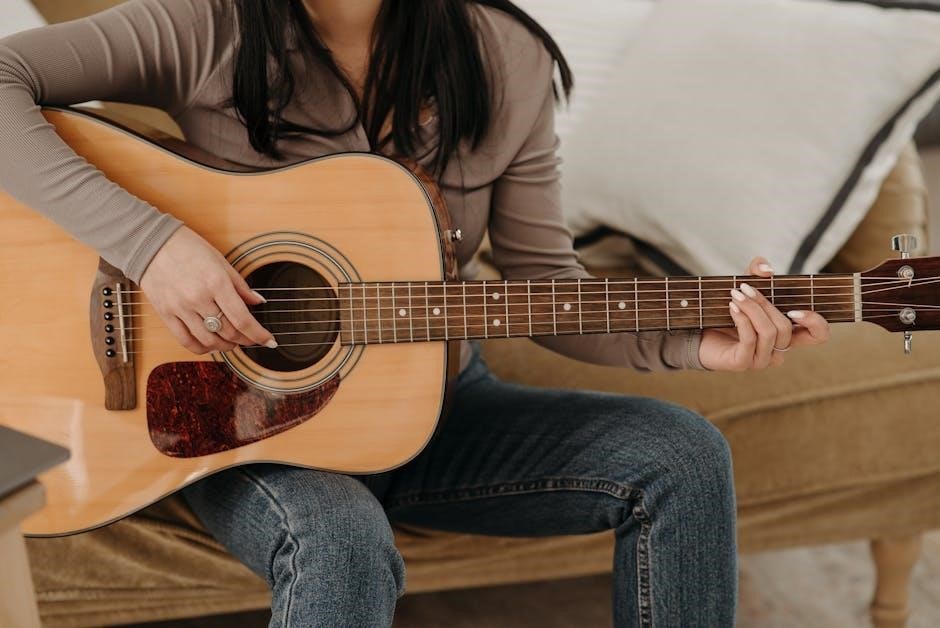acoustic guitar buying guide
An acoustic guitar is a versatile instrument, perfect for beginners and seasoned musicians alike. Known for its rich, resonant sound, it’s ideal for various genres, from folk to rock. With a wide range of body types, tonewoods, and price points, finding the right acoustic guitar can be a rewarding experience. Whether you’re seeking a budget-friendly option or a high-end model, understanding the basics ensures you make an informed decision.
1.1. Understanding the Basics of Acoustic Guitars
An acoustic guitar produces sound naturally through its hollow body and strings. Key components include the body shape, tonewoods, neck, and strings. The sound quality varies based on materials and construction. Understanding these basics helps you identify the right guitar for your needs. Acoustic guitars are versatile, suitable for various genres and skill levels. They come in different sizes and styles, making them accessible to everyone, from beginners to professionals.
1.2. Why Choose an Acoustic Guitar?
Acoustic guitars are popular for their versatility and natural sound. They suit various genres, from folk to rock, and are ideal for both strumming and fingerpicking. Unlike electric guitars, they don’t require amplifiers, making them portable and easy to play anywhere. Their rich, resonant tone appeals to many musicians. Whether you’re a beginner or an experienced player, an acoustic guitar offers a rewarding musical experience with minimal setup and maintenance.

Price Range and Budgeting
Acoustic guitars range from $100 to over $100,000, but most buyers find great value between $250 and $1,500. Set a budget and focus on quality within that range.
2.1. Entry-Level Acoustic Guitars (Under $300)
Entry-level acoustic guitars are perfect for beginners, offering affordability and decent quality. Models under $300 often feature laminated tonewoods, durable construction, and essential features like X-bracing. Brands like Ibanez and Fender offer excellent options in this range, providing clear sound and smooth playability. These guitars are ideal for learning and casual playing, ensuring a great start without breaking the bank.
2.2. Mid-Range Acoustic Guitars ($300-$1000)
Mid-range acoustic guitars offer a balance of quality and affordability, ideal for intermediate players. Models in this price range often feature solid tops, improved craftsmanship, and enhanced tonewoods for richer sound. Brands like Taylor and Martin provide excellent options, with guitars offering good resonance and playability. These instruments are versatile, catering to both fingerstyle and strumming, making them a great investment for those seeking long-term quality without breaking the bank.
2.3. High-End Acoustic Guitars ($1000-$5000)
High-end acoustic guitars are crafted with premium materials and meticulous attention to detail, offering exceptional tone and playability. These instruments typically feature all-solid tonewoods, intricate inlays, and advanced bracing patterns for optimal resonance. Brands like Gibson and Martin provide standout models in this range, ideal for professional musicians and serious enthusiasts. The investment in a high-end guitar promises lasting quality, making it a worthwhile choice for those seeking superior performance and aesthetics.
2.4. Custom and Vintage Acoustic Guitars (Over $5000)
Custom and vintage acoustic guitars represent the pinnacle of craftsmanship and exclusivity. These instruments are often hand-built by master luthiers or are rare, pre-owned models from legendary brands like Martin or Gibson. With price tags over $5000, they cater to collectors and discerning players seeking unique tones and aesthetic appeal. Vintage guitars may offer a rich history, while customs allow for personalized features, making each piece a true investment and heirloom-quality treasure.
Body Types and Shapes
Acoustic guitars come in various body shapes, each offering distinct tonal characteristics and playability. Dreadnought, Grand Auditorium, Concert, and Jumbo models cater to different playing styles and musical preferences, ensuring a perfect fit for every guitarist.
3.1. Dreadnought Acoustic Guitars
Dreadnought guitars are known for their square-shouldered body shape and robust sound. They deliver loud, balanced tones, making them ideal for strumming and flatpicking. Popularized by brands like Martin, these guitars are versatile for various genres. The Dreadnought’s full-body resonance and clear projection make it a favorite among professionals and enthusiasts alike, offering a classic acoustic experience that suits both solo and ensemble performances.
3.2. Grand Auditorium Acoustic Guitars
Grand Auditorium guitars offer a balanced sound and versatility, making them suitable for both fingerpicking and strumming. Their slightly smaller body shape compared to Dreadnoughts provides a rich, articulate tone with good mid-range clarity. Ideal for players seeking a versatile instrument, they are a favorite among modern guitarists. Brands like Taylor have popularized this body style, ensuring it meets the needs of various musical genres and playing styles.
3.3. Concert and Parlor Acoustic Guitars
Concert and Parlor guitars are ideal for fingerpicking and smaller players, offering a warmer, more focused sound. Their compact body shape produces clear highs and balanced lows, making them perfect for intimate settings. These guitars are great for folk, blues, and classical music. Brands like Taylor and Martin offer excellent models in this category, providing a rich, articulate tone that suits both beginners and experienced musicians.
3.4. Jumbo and Classical Acoustic Guitars
Jumbo guitars are known for their large body size and powerful sound, making them ideal for strumming and bold projection. They excel in genres like country and rock. Classical guitars, with their wider neck and nylon strings, are perfect for fingerstyle and classical music. Their smaller body shape delivers a warmer, more mellow tone, making them great for beginners or softer musical styles.

Tonewoods and Materials
Tonewoods like spruce, mahogany, and rosewood significantly impact sound quality and aesthetics. The top wood enhances brightness, while back and sides add warmth. Neck and fretboard materials, such as mahogany or rosewood, influence playability and tone, ensuring durability and a smooth playing experience;
4.1. Top Tonewoods (Spruce, Mahogany, Cedar)
The choice of top tonewoods significantly affects an acoustic guitar’s sound. Spruce is renowned for its clarity and sustain, making it a popular choice for dreadnought models. Mahogany tops offer a warmer, more balanced tone, while cedar provides a rich, mellow sound with excellent mid-range warmth. Each tonewood brings unique characteristics, allowing players to select the best fit for their musical style and preferences.
4.2. Back and Side Tonewoods (Mahogany, Rosewood, Maple)
Mahogany back and sides deliver a warm, balanced sound, while rosewood enhances depth and complexity with rich overtones. Maple offers a bright, crisp tone and striking aesthetic appeal. Each tonewood combination influences the guitar’s overall resonance and projection, catering to different musical genres and playing styles. Understanding these characteristics helps musicians choose an acoustic guitar that aligns perfectly with their sound preferences and artistic expression.
4.3. Neck and Fretboard Materials
The neck and fretboard materials significantly impact playability and tone. Mahogany necks are lightweight and warm, while maple necks offer brightness and durability. Rosewood fretboards provide a smooth playing experience and rich harmonics, whereas ebony fretboards deliver a snappy attack. The choice of materials affects both the guitar’s sound and the player’s comfort, making it essential to consider these factors when selecting an acoustic guitar.

Bracing and Construction
The internal bracing and construction of an acoustic guitar significantly impact its sound quality and durability. Different bracing patterns, like X-bracing, influence the guitar’s tone and stability.
5.1. X-Bracing vs. Other Bracing Patterns
X-bracing is a classic pattern that enhances stability and resonance, making it ideal for dreadnought guitars. Other patterns, like ladder bracing, offer distinct tonal characteristics, often used in smaller bodies.
5.2. Solid vs. Laminate Tops
Solid tops, made from a single piece of wood, deliver richer resonance and a more dynamic sound, especially as the guitar ages. Laminate tops, constructed from layered wood, are more durable and resistant to humidity, making them ideal for budget-friendly guitars. Solid tops are typically found in high-end models, while laminates are common in entry-level instruments. Both options offer unique benefits, catering to different needs and preferences.
5.3. Importance of Dovetail Neck Joints
A dovetail neck joint is a traditional and highly regarded method of attaching the neck to the body, offering exceptional strength and stability. This joint allows for precise adjustments, ensuring proper alignment and playability. Its design enhances sustain and resonance, making it a preferred choice for high-end guitars. While more labor-intensive, the dovetail joint provides long-term durability and is often found in mid-range to premium acoustic guitars.

Electronics and Amplification
Electronics and amplification enhance acoustic guitars by allowing their sound to be amplified for performances and recordings. Acoustic-electric guitars feature built-in pickups, while external microphones offer versatility. Popular systems like Fishman and Taylor ES2 ensure the guitar’s natural tone is preserved when plugged in.
6.1. Acoustic-Electric Guitars: What to Look For
When selecting an acoustic-electric guitar, focus on the quality of the built-in electronics and pickups. Look for systems like Fishman or Taylor’s ES2, which capture the guitar’s natural tone. Ensure the pickup accurately represents the instrument’s acoustic brilliance and offers clear, balanced sound when amplified. Additionally, consider the placement of volume and tone controls for ease of use during performances. Tonewoods still play a crucial role, so choose a guitar that balances playability and electronics. Trusted brands like Taylor and Martin excel in this category, offering models that cater to both beginners and professionals.
6.2. Built-In Pickups vs. External Microphones
Built-in pickups, like Fishman or Taylor’s ES2, offer convenience and ease of use, providing a direct signal for amplification. They are affordable and widely available. External microphones, while more expensive, deliver a purer, natural sound. They require additional equipment but are ideal for capturing authentic tone. Consider your needs: pickups are great for simplicity, while microphones suit those seeking high-fidelity sound in professional settings.
6.3. Popular Pickup Systems (Fishman, Taylor ES2)
Fishman and Taylor’s ES2 are top-tier pickup systems. Fishman is renowned for its clarity and reliability, making it a favorite among musicians. The ES2 excels at capturing the guitar’s natural tone, ideal for live performances. Both systems are highly regarded for their sound quality and ease of use, ensuring your acoustic guitar sounds its best when amplified. They are trusted choices for gigging musicians seeking professional-grade electronics.
Brand Recommendations
Prominent brands like Taylor, Martin, and Gibson are celebrated for their exceptional craftsmanship and tone. These brands offer a wide range of models, catering to diverse playing styles and preferences, making them top choices for musicians seeking high-quality acoustic guitars.
7.1. Taylor Guitars
Taylor Guitars is renowned for its innovative designs and exceptional playability. With models like the Academy 10, Taylor offers affordability without compromising on quality. The ES2 pickup system is a standout feature, capturing the guitar’s acoustic brilliance. Taylor’s commitment to craftsmanship and tone makes it a top choice for musicians, whether they’re performing on stage or recording in a studio.
7.2. Martin Guitars
Martin Guitars is a legendary brand celebrated for its iconic dreadnought models like the D-28 and D-18. Known for their rich, balanced tone and exceptional craftsmanship, Martin guitars are favored by professionals and enthusiasts alike. With a wide range of body types, from dreadnoughts to smaller-bodied options like the 00-15M, Martin offers instruments for every playing style and musical preference, ensuring a timeless sound and unparalleled quality.
7.3. Gibson Guitars
Gibson Guitars is a historic brand renowned for its round-shouldered dreadnoughts and iconic models like the J-45 and D-28. Known for their warm, balanced tone and premium craftsmanship, Gibson acoustic guitars are favored by pros and enthusiasts. Offering a range of options, from classic dreadnoughts to smaller-body designs, Gibson delivers exceptional playability and rich sound, making them a top choice for various musical genres and playing styles.
7.4. Fender and Epiphone Acoustic Guitars
Fender and Epiphone offer excellent acoustic guitar options for players of all levels. Fender’s acoustic guitars are known for their versatility, blending traditional designs with modern features, making them ideal for rock, folk, and country. Epiphone, Gibson’s sister brand, provides affordable yet high-quality instruments, delivering classic tones and craftsmanship. Both brands are great for beginners and seasoned players, offering a balance of affordability and performance across their acoustic lineups.

Action and Playability
Action refers to the string height, impacting playability. Lower action reduces fatigue, while higher action suits heavy strumming. Neck width and profile also influence comfort, ensuring smooth playing experiences for all guitarists.
8.1. Understanding String Action
String action, or string height, is the distance between the strings and the fretboard. Proper action ensures comfortable playing and prevents buzzing. Lower action suits fingerstyle, while higher action is better for heavy strumming. Adjusting the action involves modifying the bridge or nut, often requiring professional setup. Optimal action balances playability and tone, crucial for both beginners and experienced players to enjoy their instrument fully.
8.2. Neck Width and Profile
Neck width and profile significantly impact playability. Wider necks suit fingerstyle players or those with larger hands, while narrower necks are ideal for fast finger movement. Profiles range from thin, modern shapes to thicker, vintage styles. Thicker necks offer a fuller grip, often preferred by classical guitarists. The right neck width and profile ensure comfort and ease, making long playing sessions enjoyable. Personal preference plays a crucial role in selecting the perfect neck dimensions.
8.3. Setup and Adjustments
A proper setup ensures optimal playability and sound quality. Adjusting the action (string height) and intonation is crucial for comfortable playing. The truss rod fine-tunes neck relief, while bridge saddles regulate string height and intonation; A well-set guitar reduces fatigue and enhances performance. For best results, consider a professional setup, especially for high-end models like the Taylor Academy 10, ensuring it meets your playing style and musical needs.

Strings and Accessories
Choosing the right strings and accessories enhances your acoustic guitar experience. Popular string options include bronze, nylon, and steel, while cases, tuners, and picks are essential for maintenance and performance.
9.1. Choosing the Right Strings
Acoustic guitar strings are available in various materials, including bronze, nylon, and steel. Bronze strings offer a bright, crisp sound, while nylon provides a softer, warmer tone. Steel strings deliver clarity and durability. Consider factors like playability, tone preference, and budget when selecting strings. Lighter gauges are easier on the fingers, ideal for beginners, while heavier gauges produce fuller sound. Experiment with different options to find the perfect match for your playing style and musical needs.
9.2. Cases and Gig Bags
Protecting your acoustic guitar is essential, and the right case or gig bag ensures safety during transport. Hardshell cases offer superior durability and protection, often featuring plush interiors. Gig bags are lightweight and portable, ideal for frequent travelers. Look for sturdy materials, padded interiors, and reinforced handles. Higher-end cases may include additional pockets for accessories. Investing in a quality case or gig bag prolongs your guitar’s lifespan and maintains its condition, whether at home or on the go.
9.3. Tuners and Other Accessories
A reliable tuner is essential for maintaining your guitar’s pitch accuracy. Clip-on tuners are popular for their convenience, while pedal tuners offer precise tuning for live performances. Other accessories like picks, straps, and capos enhance playability. A humidifier is crucial for maintaining the guitar’s wood health, especially in dry climates. Invest in quality accessories to complement your acoustic guitar and ensure optimal performance and longevity.

Additional Features to Consider
Additional features like cutaways, electronics, and 12-string options enhance versatility. Custom inlays and aesthetics add personal style. These extras can tailor the guitar to your preferences and needs.
10.1. Cutaways and Electronics
Cutaways enhance playability by allowing easy access to upper frets, ideal for intricate fingerstyle techniques. Electronics, such as built-in pickups, enable amplification for live performances. Taylor’s ES2 system and Fishman pickups are popular choices, offering clear, balanced tones. These features are especially valuable for musicians who perform live or record, blending traditional acoustic sound with modern convenience and versatility. They add functionality without compromising the guitar’s natural resonance.
10.2. 12-String Acoustic Guitars
12-string acoustic guitars offer a rich, layered sound with doubled strings, creating a full, harmonic resonance. They are ideal for players seeking a unique tonal experience, often used in folk, rock, and classical music. Models like the Takamine GD30CE-12 provide a wide harmonic blend, while Taylor’s ES2 system enhances plugged-in performances. These guitars add depth and complexity to music, making them a great choice for those exploring expanded sonic possibilities and artistic expression.
10.3. Custom Inlays and Aesthetics
Custom inlays and unique aesthetics add a personal touch to acoustic guitars, making them stand out. Intricate designs, often crafted from materials like mother-of-pearl or abalone, enhance the guitar’s visual appeal. High-end models may feature elaborate fingerboard patterns or body ornaments, reflecting the player’s style. While aesthetics don’t directly impact sound quality, they contribute to the guitar’s overall charm and value, making it a true masterpiece for both playing and admiration.

Where and How to Buy
Consider purchasing from reputable music stores or online retailers for a wide selection. Visit stores to test guitars, ensuring a good fit. Online marketplaces often offer competitive pricing and convenience, but warranties and support should be verified before buying.
11.1. Buying from Music Stores
Buying from music stores offers a hands-on experience, allowing you to test guitars before purchasing. Knowledgeable staff can guide you, ensuring the right fit. Stores often provide warranties and after-sales support, adding value to your purchase. This personalized approach helps in making an informed decision, making it a preferred choice for many musicians.
11.2. Online Retailers and Marketplaces
Online retailers and marketplaces offer convenience and competitive pricing, making them a popular choice for buyers. Platforms like Amazon and Musician’s Friend provide detailed product descriptions, customer reviews, and comparisons. Many online stores offer free shipping, discounts, and bundle deals. Additionally, they often feature a wide selection of brands like Taylor, Martin, and Gibson, catering to all budgets. High-end models may include hard cases, enhancing overall value. Reliable online retailers ensure secure transactions and quality assurance.
11.3. Checking for Warranty and Support
When purchasing an acoustic guitar, ensure it comes with a warranty to protect your investment. Most manufacturers offer warranties covering defects in materials and workmanship, typically ranging from 1 to 5 years. High-end guitars often include extended warranties. Additionally, check for customer support options, such as maintenance tips or repair services. Some retailers also provide extended warranty plans, offering added peace of mind for buyers.

Final Tips for First-Time Buyers
First-time buyers should prioritize trying guitars before purchasing, ensuring a good fit and feel. Avoid common mistakes like overspending and neglecting long-term maintenance. Happy playing!
12.1. Trying Before Buying
Always try a guitar before purchasing, if possible, to assess playability, sound, and comfort. Visit music stores to test different models, focusing on neck feel and body size. Ensure the guitar is properly set up, as this impacts playability. Don’t rush—play several options to compare tone and comfort. This hands-on approach ensures you find the perfect fit for your style and preferences, avoiding post-purchase regrets.
12.2. Avoiding Common Mistakes
First-time buyers often overlook key factors like action height and string quality. Make sure to inspect the guitar for any structural issues, such as warping or loose braces. Avoid prioritizing aesthetics over sound quality and playability. Additionally, don’t equate higher prices with better value without proper evaluation; Lastly, ensure the guitar is set up correctly, as poor setups can hinder performance and comfort, leading to potential dissatisfaction down the line.
12.3. Long-Term Maintenance
Proper care ensures your acoustic guitar lasts for years. Maintain consistent humidity levels to prevent warping, as dry air can crack the wood. Regularly clean the fretboard and body to remove dirt and oils. Change strings every 3-4 months to preserve tone and prevent corrosion. Store the guitar in a hard case or gig bag to protect it from dust and damage. Avoid extreme temperatures to maintain stability and playability over time.